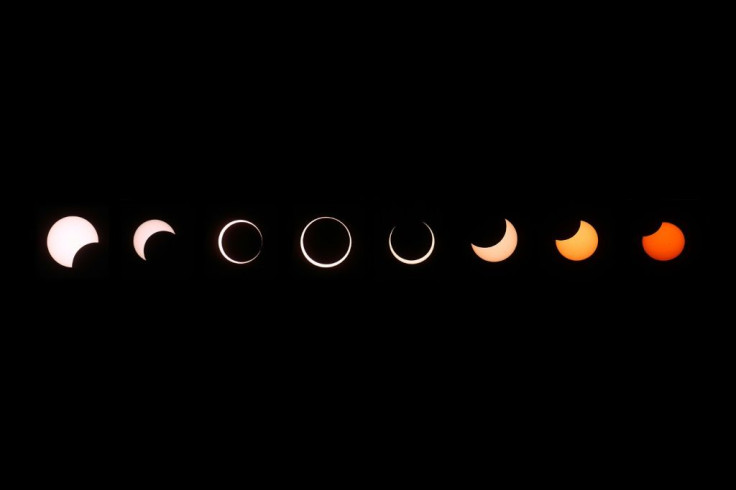LOOK: 'Ring Of Fire' Eclipse From Space And Other Stunning Views
KEY POINTS
- People across the northern hemisphere witnessed the "ring of fire" eclipse
- A satellite in space caught the moon's shadow passing over North America
- Many shared images of the sky event online
A spectacular "ring of fire" solar eclipse graced the skies in some parts of the world Thursday. Many people shared images of the sky event on social media.
Sky watchers in the northern hemisphere caught a glimpse of the annular solar eclipse. Even a satellite was able to spot the spectacle from space. A video shared by the National Oceanic and Atmospheric Administration (NOAA) shows the eclipse "from a different perspective," as captured by the GOES-East Satellite.
As the sun rose this morning, an annular #SolarEclipse occurred, where the moon moved between the Earth and the Sun, but didn't completely cover our view of it. The #GOESEast 🛰️ saw the event from a different perspective, and captured the moon's shadow over North America. pic.twitter.com/In07k9jdfI
— NOAA Satellites (@NOAASatellites) June 10, 2021
In the short footage, one can see the dark shadow pass over North America. Another satellite view of the eclipse was shared by Space.com, showing the shadow of the moon on the Earth.
Interestingly, it was also a GOES satellite that captured incredible views of the 2020 solar eclipse from space.
Those who didn't get to witness the event, whether because it was too cloudy or they simply missed it, need not worry as many people have shared their stunning views of the eclipse online. In parts of the U.S., for instance, many even woke up early just to see it as the sun was rising.
One online user shared an image of the eclipse showing the sun behind the Statue of Liberty. The sun had a crescent shape as it was partially covered by the moon.
The Statue of Liberty at sunrise today, during the "ring of fire" partial solar eclipse. pic.twitter.com/pGSkB2SheB
— Jon Cooper (@joncoopertweets) June 10, 2021
Another view shows a stunning view of the eclipsed, rising sun. NASA also shared images of the eclipse from the East Coast.
Partial eclipse rising over DC this morning ☀️ #Eclipse2021 pic.twitter.com/QybxaVlUr2
— Andy Feliciotti 🔥 (@sup) June 10, 2021
Today, people in parts of the Northern Hemisphere saw a partial or annular solar eclipse! 🌙 Here are a few of our photos from the East Coast. https://t.co/4Q9RjQaePq #SolarEclipse
— NASA Sun & Space (@NASASun) June 10, 2021
Did you see the eclipse? Show us your photos! pic.twitter.com/UqTZai3MX4
Denis Laurin, a space astronomy scientist at the Canadian Space Agency (CSA), captured rather eerie views of the eclipse, while another Twitter user even shared an incredible timelapse of the event.
Stunning photos of this morning’s annular #eclipse taken by Denis Laurin, CSA’s Space Astronomy Scientist. #Eclipse2021 pic.twitter.com/ECNoMKTM3W
— Canadian Space Agency (@csa_asc) June 10, 2021
Time-lapse of #Eclipse2021 - had to get up early but it was so worth it. pic.twitter.com/uwWM9S0AXU
— Kaylee (@AniMeiGrrl) June 10, 2021
An annular eclipse happens when the moon passes between the Earth and the sun. But since the moon is farther away from the Earth and thus looks smaller, it doesn't block the entire sun and instead just causes a "ring of fire."
This isn't the last eclipse for 2021, as a partial eclipse of the moon will be visible from North America and Hawaii on Nov. 19. A total solar eclipse will also happen on Dec. 4, although it won't be visible in North America. It could be seen from places like the Falkland Islands and Antarctica.

© Copyright IBTimes 2024. All rights reserved.












